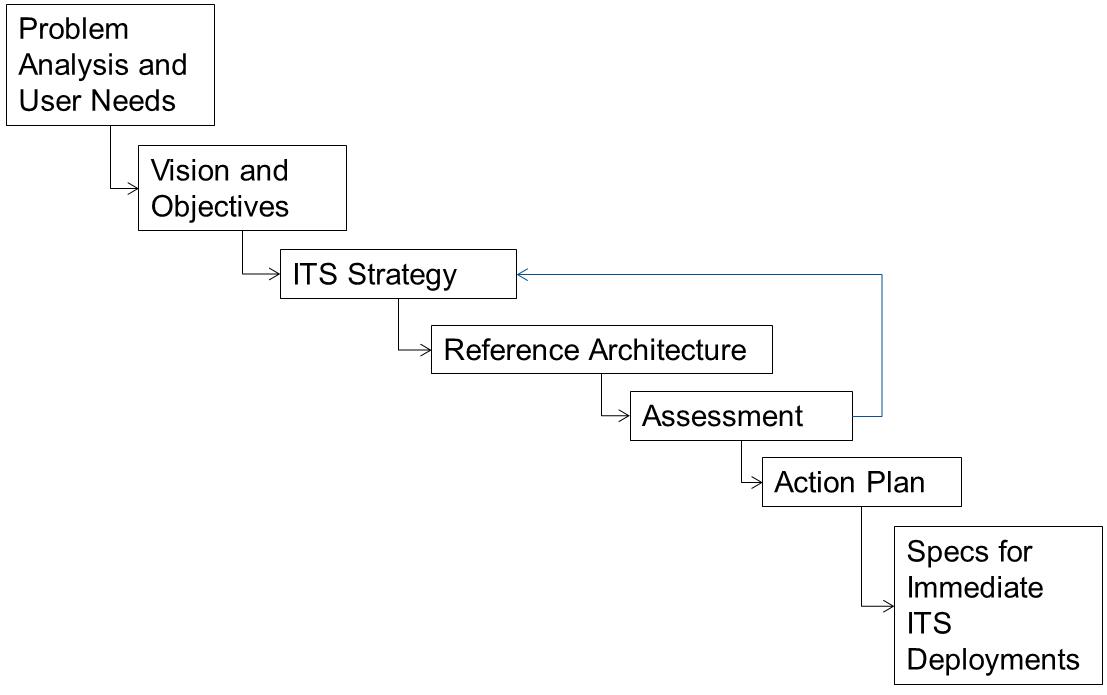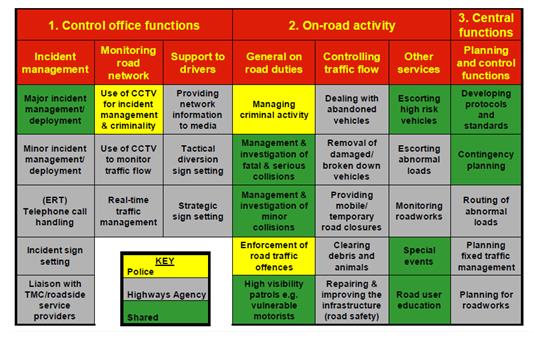
Road Network Operations
& Intelligent Transport Systems
A guide for practitioners!

Road Network Operations
& Intelligent Transport Systems
A guide for practitioners!
ITS investments almost always involve a wide range of stakeholders and interest groups from the public, private, and non-profit sectors. In some countries, the research, academic and non-profit institutions also play a key role because of the involvement of advanced information and system technologies, and the level of coordination that this requires.
Getting the ITS deployment strategy right is essential for the effective and timely deployment of ITS measures – and to avoid wasted time and resources. This requires an understanding of the purpose and objectives of road network operations. (See Purpose and Objectives) Particular issues that need to be addressed include:
Investment in ITS is not an end in itself. The use of ITS must be cost-effective and compatible with the policy aims and objectives of the overall national transport strategy. In many countries, transport master plans make no reference to ITS applications and services. Proposals for ITS-based services that serve travellers and other road users can add substance to transport strategies in terms of practical measures for their delivery.
To ensure that ITS is not overlooked in the transport planning process, a well-considered and easily understood ITS Strategy is required that shows the direct links with the national transport strategy. In summary, the reasons for developing an ITS national and/or regional deployment strategy, are to:
In Egypt, a national ITS Strategy is being developed by the Ministry of Transport encompassing a clear vision and priorities for the deployment of ITS services in the short-term, medium-term and long-term. The ITS Strategy is clearly defined with project packages clearly specified for immediate implementation.

An Example of Approach for Developing an ITS Strategy
The development of an ITS Strategy should, if possible, evolve through a consensus process involving multiple stakeholders to understand their expectations, priorities and boundaries. Careful planning will take into account the local culture and transport profile so that ITS can be adapted and customised to meet the particular needs. (See Basic ITS Concepts)
One of the important lessons learned from ITS deployment is that resolving institutional issues is a key to success, and addressing them takes time and commitment. The advice is “Do not start too late. Involve all key stakeholders early on.”. This can help anticipate and resolve technical and institutional issues. Mechanisms such as steering groups and pilot projects can help win the support of major stakeholders for ITS deployments.
Countries in the early stages of deploying ITS can take advantage of this hard-learned experience – by seeking to understand stakeholder and user needs as the outset of any ITS development and addressing institutional issues early on. (See Regulatory Framework)
According to World Bank Technical Notes, for ITS to be successfully introduced, a number of institutional prerequisites must be met – in some cases, legislation and institutional change may be necessary:
Key elements in the process of establishing an ITS strategy are:
Overcoming opposition requires political commitment to convince stakeholders that their concerns are understood and taken into account.
A regional ITS strategy covering several regions within a country or several neighbouring countries is necessary to achieve harmonised deployment and use of ITS services. The size of the region and the complexity of transport operations that need to be integrated will determine the levels of interoperability required. (See Integrated Operations)
International freight operations and electronic toll collection for trucks moving across borders within the region benefit from interoperability based on common standards and harmonised back-office systems. In regions which do not have an agreed ITS strategy in place, the risk of fragmented deployment of various ITS systems of different standards is high.
Certain regions around the world have cooperated to develop regional ITS strategies – such as ERTICO in Europe, ITS America and ITS Canada in North America, ITS Japan and ITS Australia in Asia Pacific. Countries in the European Union have developed a legal framework to achieve greater harmonisation.
The European ITS Directive (Directive 2010/40/EU of 7 July 2010) provides a legal framework for the deployment of ITS services across Europe.
Priority areas:
Priority actions:
Information about the European ITS Directive and ITS Action Plan is available on the Commission’s website.
In the Middle East and North Africa (MENA), no regional ITS strategies have been agreed between the various countries but regional ITS associations – such as ITS Arab – have an important guidance role in facilitating harmonised regional deployments. Many Arab Gulf states that were pioneers in ITS deployment now face a situation where there is a mix of legacy systems and standards – without harmonised specifications. ITS Arab has begun work on developing an ITS system architecture to help ensure some compatibility of specifications for ITS deployments in future in the MENA countries.
Many countries, such as Argentina and Malaysia, have recently created national ITS organisations. Other countries in Africa, apart from the long-established ITS South Africa, have recently created national associations to jump start ITS programmes and integrate key players at a national scale (such as Nigeria, Ethiopia and Egypt. Many of the new associations have received support from established international associations. For example, ITS Egypt received good support from ITS South Africa and ITS UK.
Key players can often be grouped into seven major categories:
Active dialogue is needed to identify each stakeholder’s interests in the deployment of ITS – their perceived problems, expectations, roles and responsibilities. Within each organisation it is essential to identify the staff with the understanding and skills to engage with ITS. This requires professional development, awareness raising, training and education in the broadest sense about ITS – of technicians, decision makers (including the politicians), senior management and administrators. (See Professional Capacity Building)
In Egypt, a national committee of all key players was set up by the Ministry of Transport for high-level coordination of ITS development. The committee was established at ministerial level, with the authority to influence the decisions of the key organisations and agencies regarding adoption of a national ITS architecture, data exchange formats and the use of international standards.
Often ITS champions will be individual experts having had experience of ITS development and deployment at the international level and with a desire to advance deployment in their home country. Individually they can contribute their experience but with the support of national Ministries and organisations they can mobilise stakeholders to help solve transport problems. An ITS study tour to countries where ITS is widely deployed can help raise awareness and understanding of its possibilities.
A national or regional task force of the major players, with high-level political backing, can also help to develop voluntary agreements and memoranda of understanding (MOUs) between operating partners on matters of common concern.
Within Hefei China, a major champion of ITS deployment was the Research Centre for Software Engineering Technology in Anhui Province – one of the main technology centres of development in the city. International cooperation – between the German Aerospace Centre (DLR) and other German partners with Hefei’s municipal traffic police, Department of Communication and other partners – led to an ambitious ITS programme being developed. It was integrated within the city’s traffic and transport investment plans.
New legislation in the UK created “Traffic Officers” invested with powers to undertake certain traffic management tasks previously carried out by the police – such as to:

Source: Highways England, UK
The establishment and maintenance of an ITS programme can be greatly facilitated by a policy commitment to multi-year funding for ITS activities. Without this kind of commitment a strategy for ITS deployment will be difficult to sustain because of start-up capital costs and year on year operational costs.
Enabling legislation supports the introduction of policies and procedures for ITS applications that:
ITS consists of a wide range of services and products, some of which are now very well established (such as traffic signal coordination). Adapting applications to local conditions is always necessary – for instance, so coordinated traffic signals work in mixed traffic of cars, two-wheelers and non-motorised vehicles. Transport agencies have an important responsibility to lead this adaptation in their instructions to consultants and suppliers.
China has a strategy of introducing state-of-art technologies in transport. In Hefei, after an analysis and assessment period to develop ITS plans – an ambitious ITS deployment programme was proposed for huge investment in road and public transport infrastructure and services. The strategy requires wide-spread deployment of advanced traffic monitoring and control equipment across the city’s road network.
Stage one focuses on traffic monitoring and involves a programme of data collection based on traffic probes (Floating Car Data) using more than 7,000 taxis and trucks covering the Hefei urban road network. The data are utilised in digital and multimedia broadcasting of traffic information and for public transport planning.
Staged progression of ITS deployments gives the opportunity for stakeholders and users to gain confidence in the new systems and lay the ground for future plans. This can include developing small-scale pilot deployments of priority ITS services to demonstrate their viability and to fine-tune the designs and operational arrangements – in preparation for wide-scale deployment.
The Egypt ITS Strategy includes the Cairo Ring Road which has an annual average daily traffic of more than 120,000 vehicles per day and is amongst the most heavily used roads in the national network. It was chosen as the first pilot ITS project in Egypt for the deployment of integrated traffic detection and management measures on more than 90 km of roads. Its significance – apart from its importance in easing many of Cairo’s traffic congestion problems – is as a pilot deployment for testing and developing the necessary technical and operational requirements in anticipation of extending ITS to other road corridors.